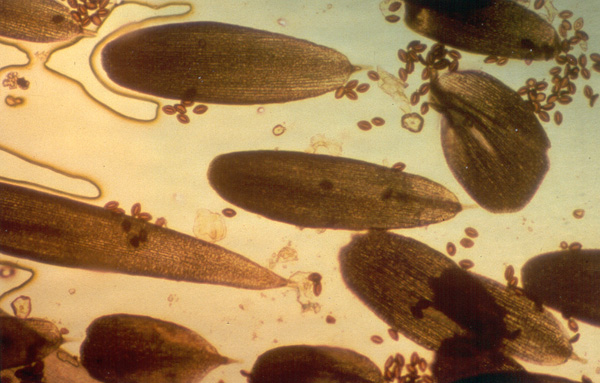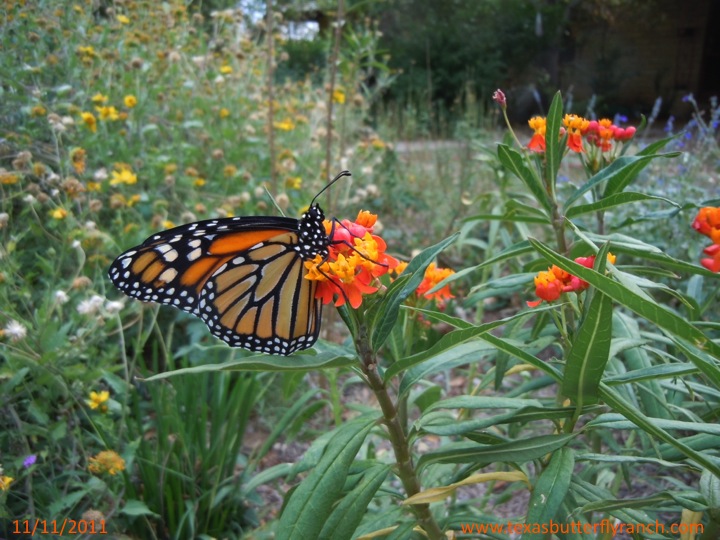In the last two weeks, both the New York Times and professional butterfly breeders have made progress in raising awareness of a little known but possibly significant factor in the decline of the Monarch butterfly migration–a spore driven, Monarch-centric disease known as OE.

OE spores look like little footballs next to Monarch butterfly scales. The spore-driven disease can be devastating to the butterflies. Photo courtesy of MLMP
Ophryocystis elektroscirrha, known in the Monarch community as OE, infects Monarchs and other butterflies that host on milkweed, sometimes resulting in butterfly crippling or death. Spores transfer from creature to creature via physical contact with each other or the plants on which they rest or eat, thus scientists worry that local OE-infested Monarchs will infect populations that are passing through, possibly jeopardizing the migration.
Several sessions at the Butterfly Professionals Conference held in Ft. Lauderdale, Florida, November 12 – 16, were dedicated to educating about 100 attendees on prevention of the disease. The organization has been called to task in the recent petition to list the Monarch butterfly as “threatened” under the Endangered Species Act for releasing butterflies that could carry OE into the wild population.
Connie Hodsdon, a butterfly breeder and owner of Flutterby Gardens in Bradenton, Florida, addressed the joint meeting of the International Butterfly Breeders Association (IBBA), the Association for Butterflies (AFB) and the International Association of Butterfly Exhibitioners and Suppliers (IABES), in a 90-minute session focused exclusively on OE.

Monarch butterfly on Tropical milkweed. Photo by Monika Maeckle
“You have to start clean and stay clean,” said Hodsdon before sharing slides of mottled, dark speckled OE-infected Monarch chrysalises. She then launched into a detailed description of the methodology she employs for preventing or eliminating OE from butterfly livestock.
Her approach includes multiple bleach baths of Monarch eggs, breeding vessels, and all plant material in a special product imported from Great Britain called Milton, separate rearing rooms for different broods of butterflies, and regular testing with a microscope for OE spores.
“We have to do everything in our power to make sure our Monarchs are an asset to the species,” Hodsdon told the conference crowd. “If you can’t, find another species to raise.”
Later, butterfly breeder Edith Smith, owner of Shady Oak Butterfly Farm in Brooker, Florida, continued the call-to-action for breeders to be meticulously clean in their operations and monitor livestock closely–not just for OE, but for more pervasive and difficult-to-cure plagues.
Smith, who teaches various workshops and seminars about butterfly diseases that nature uses for population control, has been raising butterflies commercially since 1999. She proposed that OE should be eliminated before it even enters the breeding operation.
“These are diseases that butterfly breeders must keep out of their breeding facilities,” she said.
Both Smith and Hodsdon keep a 100x microscope on hand along with clear, invisible tape. They check Monarch and Queen butterflies for OE spores by rolling the abdomen of young butterflies along the tape, then viewing the tape under the microscope. If football-like spores are prevalent, the butterfly is destroyed rather than used as a breeder or sold as livestock.
“If this is done and any milkweed that wild butterflies can touch is disinfected, OE shouldn’t ever be an issue,” said Smith.
A week after the IBBA Conference, the New York Times caused a storm with citizen scientists and butterfly gardeners by focusing on possible negative impacts of planting Tropical milkweed to attract Monarch butterflies. Some scientists believe that planting Asclepias curassavica, Tropical milkweed, outside certain ranges creates hotbeds of OE that could negatively impact the population and the migration. Monarchs will only lay eggs on their host plant, which is any member of the Asclepias species.
In an article headlined For the Monarch Butterfly, a Long Road Back, and promoted heavily online as “Monarch Butterflies: Loved to Death?” science journalist Liza Gross explored the pros and cons of planting Tropical milkweed. To read our original story on this topic, check out Tropical Milkweed: To plant it or not, it’s not a simple question.
The article featured an interview with Dara Satterfield, a PhD student at the Odum School of Ecology at the University of Georgia. A native of Marietta, Georgia, Satterfield’s dissertation focuses on the relationship between migration and infectious disease in wildlife. Monarchs are her species focus.

Dara Satterfield first visited San Antonio to inspect our milkweed patch along the San Antonio River Walk in early 2013. Photo by Monika MAeckle
Satterfield works closely with Monarch scientist Dr. Sonia Altizer, the foremost expert in the country on OE. (NOTE: Dr. Altizer recently hosted a webinar for commercial butterfly breeders on how to prevent OE at their farms.)
This is the line that really whipped up butterfly fans: “…Well-meaning efforts by butterfly lovers may be contributing to the Monarch’s plight.” The piece then stated that planting Tropical milkweed, the only Asclepias species available commercially, might be doing more harm than good because it might cause butterflies to stick around, not migrate and spread the OE spores year-round.
Confused? Are you wondering what to plant when scientists and conservationists encourage us to help Monarchs by planting milkweed, yet when we do, we’re told it promotes a deadly Monarch butterfly disease?
Me, too. What’s a butterfly gardener to do? I tracked down Satterfield to provide direction.
“The monarchs are showing us something…and the pattern is clear and consistent,” Satterfield said via email, explaining that Monarchs are much more likely to be sick in places where Tropical milkweed grows year-round.
“In a nutshell, this is how we would summarize for gardeners: Choose native milkweeds whenever possible,” she said. Satterfield insists that Tropical milkweed should be limited in areas where it might survive the winter–coastal Texas, California, Florida, for example. Overwintering of the plant enables winter-breeding and high levels of OE infection, she contends.
She recommends if you DO plant Tropical milkweed in a place that rarely freezes, best practice would include cutting the plant to the ground so as not to harbor overwintering OE spores.
For the record, consensus on the science of how Tropical milkweed effects or not the Monarch migration is as elusive as the butterflies themselves. Dr. Chip Taylor of Monarch Watch told the New York Times that Tropical milkweed constitutes “a tiny, tiny portion” of the milkweeds encountered by Monarchs returning in the spring. “Should they be there? Probably not. But will they do immense harm? Probably not.”
But, to play it safe, slash that Tropical milkweed to the ground this winter if a good freeze doesn’t do it for you.
Related posts:
- Endangered Species Act: Wrong Tool for the Job of Monarch Butterfly Conservation
- Milkweed Shortage Sparks “Alternative Fuels” for Monarch Butterfly Host Plant
- Migration Update: Lone Cat on Llano River, Butterfly “Cloud” Spotted in St. Louis
- It Takes a Village to Feed Hungry Monarch Caterpillars
- Desperately Seeking Milkweed: Milkweed Shortage Creates Butterfly Emergency
- Pollinator Power on the San Antonio River Walk
- 2014 Monarch Butterfly Migration: Worst Year in History or Hopeful Rebound?
- How to Raise Monarch Butterflies at Home, Part One
- First Lady Michelle Obama Plants First Ever Pollinator Garden at the White House
- Monarch Butterfly Numbers Plummet: will Migration become Extinct?
- NAFTA Leaders, Monsanto: Let’s Save the Monarch Butterfly Migration
Like what you’re reading? Follow butterfly and native plant news at the Texas Butterfly Ranch. Sign up for email delivery, like us on Facebook, or follow us on Twitter, @monikam.


We will start our monitoring of the San Antonio Riverwalk Monarchs for O. e. with a workshop on Dec. 6 at 10:30 am at the milkweed patch at Schiller and Quincy.
I have to disagree with Dr Taylor. As noted earlier in your post, Tropical MW is one of the only milkweeds available commercially. Almost everyone I’ve ever dealt with that was just starting out in butterfly gardening has planted Tropical MW. I’d even go so far as to say it is the first MW chosen by the majority of new people.
At what time of the year should those of us living in the warmer climates cut the MW down to the ground? I still have a couple of pods not ready yet. My concern is if we do it at the wrong time there will be no MW for the Monarchs when they start to migrate north. Should there be an agreed time that everyone thinks is best? I have been able to start other variety fom seed but the majority of what I have is the tropical. Someone gave me some to plant at the local elementary school but do not want it to be a problem later.
Captive bred monarchs, commercial and scientific stock, are often raised on A.currisavica. Have infection rates been climbing as more and more A.currisavica gets planted? Isn’t it a good thing to have a fresh, untainted, thriving patch of currisavica ready and waiting for the first wave of monarchs that drop into Texas and Oklahoma? Compulsive pruners like myself already know that trimming common milkweed and currisavica results in thicker and robust plants anyway. I believe that cultivating a healthy stand of currisavica, trimmed for lush growth all year round would promote a healthy wild migrating and non-migrating population.